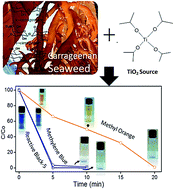Fabrication of carbon and sulphur-doped nanocomposites with seaweed polymer carrageenan as an efficient catalyst for rapid degradation of dye pollutants using a solar concentrator†
Abstract
Here we demonstrate direct use of sulphate rich seaweed polysaccharides, carrageenans, namely kappa (κ-), iota (ι-) and lambda (λ-) as source of sulphur and carbon doping in TiO2 photocatalysts. During TiO2 synthesis in the presence of sulphate rich carrageenan leaves, mainly residual carbon and sulphur doping resulted in a highly active photocatalyst. Evaluation of the dye degradation pattern shows rapid degradation of reactive black-5, methylene blue & methyl orange using modified TiO2 nanocomposites in different light sources. Robust dye degradation was achieved between 1 and 4 h under daylight whereas, the use of a solar concentrator reduced the degradation time of MB and RB-5 to <5 min and MO solution was turned colourless within 20 min. The present study elaborates the effect of seaweed carrageenans in inducing heteroatoms like sulphur and residual carbon for the photodegradation of industrially important dyes.


 Please wait while we load your content...
Please wait while we load your content...